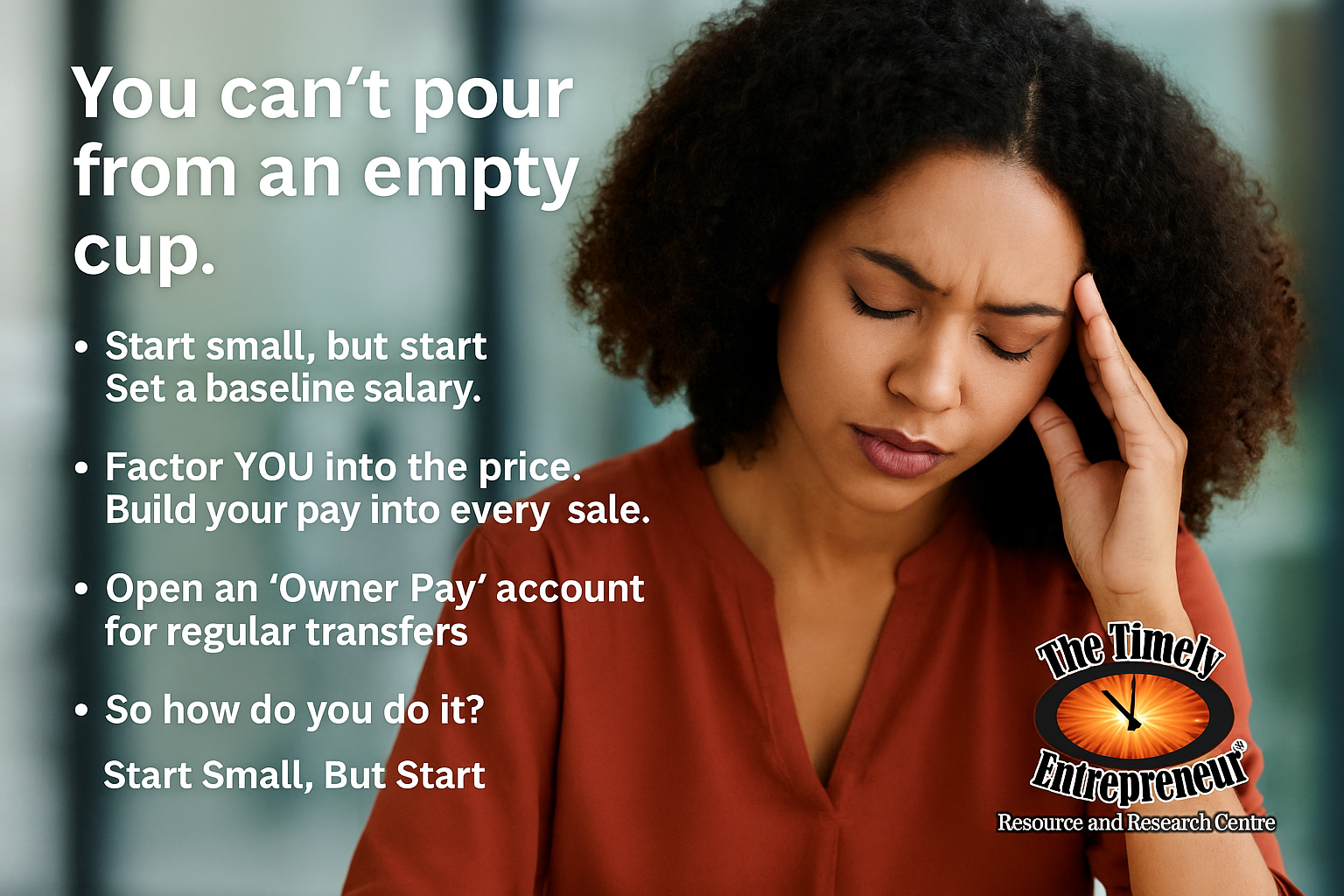
Pay Yourself as an Entrepreneur!
Let’s get honest:
Too many small business owners are making sales but not taking home a cent for themselves. They’re covering all expenses: paying rent, covering suppliers and even spending on Facebook ads. But when it’s all said and done, they’re left empty. You’ve got to pay yourself as an entrepreneur!
What no one tells you is this:
If you don’t build your business in a way to pay yourself, your business will never truly work for you. And eventually, you’ll burn out, be frustrated and financially stressed, wondering where all the money went.
But how can you pay yourself when sales are low or inconsistent?
Let’s break this down. Here are some ways The Timely Entrepreneur worked out:
Shift Your Mindset First
Stop treating your salary as a reward. A salary is not something you earn only if things go well. It’s a non-negotiable business expense just like internet bills, inventory or accounting fees. So, if your business has a monthly operating budget, your pay must be included in it even if it’s small. If it’s not in the budget, then you’ve built your business model wrong!
Pay Yourself a Percentage, not a Fixed Amount
When revenue is low or inconsistent, we understand that a fixed salary can be stressful. Instead, pay yourself a percentage of net revenue or profit.
For Example: If your business earns $8,000 this month, and your fixed expenses are $5,000, you’re left with $3,000.
Choose a percentage, let’s say, 30% of net profit and pay yourself $900.
This leaves room for reinvestment while still honouring your role in the business.
Pro tip: Choose a percentage that aligns with your goals (10% if you’re reinvesting heavily, 30–50% if it’s your main income).
But what if the business owns less than $5000 TT per month? How can one pay one’s self a salary from that?
Now that’s a very real situation and one that many small businesses face.
If your business earns less than $5,000 TT per month, you can still pay yourself a salary, but it requires intentional structure, discipline, and understanding of your business priorities.
Here’s how it can be done realistically:
Shift from “Salary” to “Owner’s Draw” Temporarily – Open a Separate Business Account & “Owner Pay” Account
Whether you’re a sole trader, company or other business structure, set up 2 accounts:
- Business Account for all income and expenses
- Owner Pay Account where your salary is transferred monthly or biweekly
Why? Because when all your business money is mixed with personal expenses, it’s easy to “borrow” from yourself and lose track. This system helps build discipline.
Instead of thinking in terms of a formal salary (like in a job), think of it as an owner’s draw – a small, planned amount you take out every week or month from what’s available after expenses.
Example:
If you earn $4,800 TT/month and your bare minimum business expenses (inventory, data, delivery, etc.) are $3,000:
→ That leaves you with $1,800 TT.
→ Decide to give yourself a set draw of maybe $1,000, and keep the remaining $800 for savings or reinvestment.
If you use the percentage rule to stay consistent, simply choose a fixed percentage, no matter how small. 10%–20% of total revenue is a good place to start. If your sales fluctuate:
“This month I made $3,500, I’ll still pay myself 15%, which is $525. Next month might be higher or lower, but stay consistent in percentage, not amount.”
This teaches you to think like a disciplined business owner, even at low-income levels.
Build Your Pay into Your Pricing
Ask yourself: “Is my current pricing too low to ever support me?”
If your profit per sale is only $10 or $20, you’ll need to sell 100+ items per month just to pay yourself. That’s not sustainable.
Even when you’re starting small, build your pay into your cost formula:
Selling Price = Cost of Product + Expenses + Your Pay + Profit Margin
If you pay yourself just $100 per week now, design your pricing around that goal.
If you can’t afford to pay yourself based on your current pricing, maybe you’re undercharging.
- Are your prices based on actual cost + value?
- Are you accounting for your labour, creativity, and time?
Your salary must be a line item in your cost structure.
Even if you’re not a limited company, you are still the engine behind it all. Don’t price yourself out of your own business.
Use the Profit First Model (Simplified)
Consider this simplified system:
Every time you get paid:
- 50% → business expenses
- 30% → owner salary
- 10% → taxes
- 10% → savings/reinvestment
Adjust based on your stage, but the idea is to put money where it matters most — not where it simply disappears.
Manage Personal Expenses with Intention
Yes, this may mean that you have to cut personal costs to make it work. This part is tough, but necessary. If you are drawing $1,000–$1,500 TT/month from the business, then your personal expenses must be minimal. Your personal budget has to reflect that reality.
This might mean:
- Delaying luxuries
- Cutting unnecessary subscriptions
- Getting creative with meals and transportation
- Staying with family while you build
This sacrifice will just be temporary, don’t worry. Discipline now creates freedom later.
Set a Minimum Survival Salary
Calculate what’s the least you need to survive personally each month (food, transport, phone credit, etc.). Let’s say it’s $1,200 TT.
If your business can’t make room for at least that, then:
- You either need to increase sales
- Or reduce business costs
- Or diversify income (side hustle, part-time work, etc.)
Consider Paying Weekly, Not Monthly
It’s often easier to manage small amounts weekly. For Example: If you only earn $4,000 TT/month, pay yourself $250–$300/week consistently. It feels more manageable and ensures you’re not always “waiting on month-end” to eat or live.
Track EVERYTHING.
The truth is in the numbers. Track:
- Every dollar you earn
- Every expense
- What you pay yourself
- What’s left behind
This builds self-awareness and helps you see what’s realistic and where changes are needed.
If your business can pay everyone and everything else but not you, it’s time to re-evaluate.
As Entrepreneurs, we need to hold ourselves accountable for what goes on in our businesses. We need to develop discipline in our spending, in our pricing, and in how we manage our most liquid asset, cash, because if we keep building businesses that starve the builder, we’re only building resentment, and that’s not why you started your business. You don’t wait to start paying yourself after your business gets big. You pay yourself so that your business has something to grow you into.
Have you started paying yourself yet, or are you still trying to figure it out? Check out our Business in Trouble Sessions and reach out to us for all your business needs.
